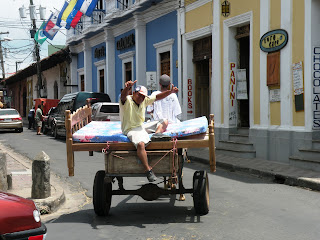As we were leaving, a huge storm was
coming in. So as we tried to walk out of the dump, a strong wind was blowing
trash and dirt all over us. We were picked up about a minute before a
monsoon-like rain began.
To the Ends of the Earth
Wednesday, August 29, 2012
La Chureca
Sunday, July 8, 2012
Saturday, July 7, 2012
Wednesday, July 4, 2012
Census in Gruta Javier
This week I have been doing a census in a barrio up the hill, Gruta Javier.
We didn’t really know anything about the community, besides where it is and
that it appears to be very poor. Eduardo, one of the Project HOPE staff, is
helping me. We are doing a short survey that asked for names and ages of
household members, as well as monthly income and the type of house they live in
(i.e. corrugated metal, cement block, etc.). I also take a picture of the
family for Project HOPE to use in the future if they decide to partner with the
community. In the middle of the community is a huge building project; the
government is building apartments for single mothers that will cost
approximately $30/month. This means the community will be growing significantly
in the near future.
Eduardo is hilarious. He is in charge of children’s ministry
at Project HOPE and used to be a professional soccer player in Nicaragua. He is
learning ventriloquism, so when we see kids in the community he talks to them
in a funny voice with his mouth closed (this produces amused looks from the
older kids). When a kid was looking at the truck we came in, Eduardo pretended
his voice was the truck talking and the child looked confused and walked away. Eduardo
is learning English, so he is always keen to learn new words and their
pronunciations. He will make me repeat words he doesn’t know and write them
down. Since we are both learning each other’s languages, sometimes our
conversations are quite entertaining. When we were driving up to the barrio
yesterday he pointed out a woman we had interviewed for the census the day
before and said, “We censed her yesterday”. When I saw two men using roosters
for a cock fight, I said, “look they are fighting with the chickens!” and
Eduardo responded, “no, it is like boxing”.
 |
| Eduardo |
Picture links
Pictures from my mini vacation: click here
Pictures from the new barrio I have been working in: click here
Pictures from the new barrio I have been working in: click here
Monday, July 2, 2012
Lessons from a beginning surfer
Surfing is hard
They’re called rash guards for a reason
The surf board is heavier when you are
leaving the water
If you don’t lift the front of your board
when a wave comes, the board will hit you
If your board drifts sideways as you are
going out, the board will hit you
When you fall off the board, come up from
the water with your hands over your head, or the board will hit you
If you want to be a surfer, you have to
watch the tide
Lots of big waves are not a good thing
Getting back on the horse
I haven’t ridden a
horse since I was about 12, so it took me awhile to remember how when a local
rancher took me down the beach and through sugarcane fields on horseback. After
about 15 minutes, when my thighs were
screaming at me and I was terrified of falling off, I remembered I could raise
myself off the horse and hold on with my legs. Things went much more smoothly
after that. While riding, I got to see fishing Nica-style. The men stand in the
waves about knee deep and swing fishing line above their heads lasso style,
then cast it out into the water. The line resembles a kite string in the way
they have it wrapped. This was part of a great mini vacation I had this weekend
at Los Cardones Surf Lodge. The lodge is an eco-friendly and socially
responsible retreat. There is not electricity in the cabanas, and they have
composting toilets. Everything is on the beach, so naturally, the view is
amazing. I spent a lot of time swinging in the hammocks and relaxing. I saw
countless iguanas and large red and blue crabs. The toads come out en mass
after dark, so I had to watch my step. I also learned how to surf (for my
thoughts on that, you can see the next post). Now I am back at Project HOPE and
quite sore. I will be starting a census in a barrio up the hill from the base
that we haven’t worked in before.
Subscribe to:
Posts (Atom)


























